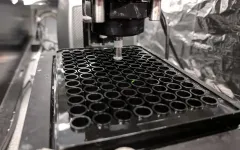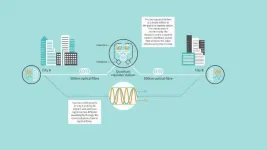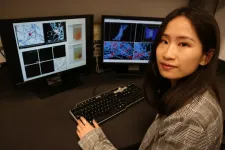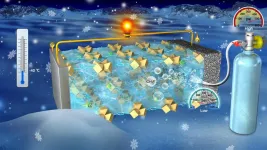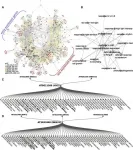(Press-News.org) Anyone who collects mushrooms knows that it is better to keep the poisonous and the non-poisonous ones apart. Not to mention what would happen if someone ate the poisonous ones. In such "classification problems", which require us to distinguish certain objects from one another and to assign the objects we are looking for to certain classes by means of characteristics, computers can already provide useful support to humans.
Intelligent machine learning methods can recognise patterns or objects and automatically pick them out of data sets. For example, they could pick out those pictures from a photo database that show non-toxic mushrooms. Particularly with very large and complex data sets, machine learning can deliver valuable results that humans would not be able to find out, or only with much more time. However, for certain computational tasks, even the fastest computers available today reach their limits. This is where the great promise of quantum computers comes into play: that one day they will also perform super-fast calculations that classical computers cannot solve in a useful period of time.
The reason for this "quantum supremacy" lies in physics: quantum computers calculate and process information by exploiting certain states and interactions that occur within atoms or molecules or between elementary particles.
The fact that quantum states can superpose and entangle creates a basis that allows quantum computers the access to a fundamentally richer set of processing logic. For instance, unlike classical computers, quantum computers do not calculate with binary codes or bits, which process information only as 0 or 1, but with quantum bits or qubits, which correspond to the quantum states of particles. The crucial difference is that qubits can realise not only one state - 0 or 1 - per computational step, but also a state in which both superpose. These more general manners of information processing in turn allow for a drastic computational speed-up in certain problems.
Translating classical wisdom into the quantum realm
These speed advantages of quantum computing are also an opportunity for machine learning applications - after all, quantum computers could compute the huge amounts of data that machine learning methods need to improve the accuracy of their results much faster than classical computers.
However, to really exploit the potential of quantum computing, one has to adapt the classical machine learning methods to the peculiarities of quantum computers. For example, the algorithms, i.e. the mathematical calculation rules that describe how a classical computer solves a certain problem, must be formulated differently for quantum computers. Developing well-functioning "quantum algorithms" for machine learning is not entirely trivial, because there are still a few hurdles to overcome along the way.
On the one hand, this is due to the quantum hardware. At ETH Zurich, researchers currently have quantum computers that work with up to 17 qubits (see "ETH Zurich and PSI found Quantum Computing Hub" of 3 May 2021). However, if quantum computers are to realise their full potential one day, they might need thousands to hundreds of thousands of qubits.
Quantum noise and the inevitability of errors
One challenge that quantum computers face concerns their vulnerability to error. Today's quantum computers operate with a very high level of "noise", as errors or disturbances are known in technical jargon. For the American Physical Society, this noise is " the major obstacle to scaling up quantum computers". No comprehensive solution exists for both correcting and mitigating errors. No way has yet been found to produce error-free quantum hardware, and quantum computers with 50 to 100 qubits are too small to implement correction software or algorithms.
To a certain extent, one has to live with the fact that errors in quantum computing are in principle unavoidable, because the quantum states on which the concrete computational steps are based can only be distinguished and quantified with probabilities. What can be achieved, on the other hand, are procedures that limit the extent of noise and perturbations to such an extent that the calculations nevertheless deliver reliable results. Computer scientists refer to a reliably functioning calculation method as "robust" and in this context also speak of the necessary "error tolerance".
This is exactly what the research group led by Ce Zhang, ETH computer science professor and member of the ETH AI Center, has has recently explored, somehow "accidentally" during an endeavor to reason about the robustness of classical distributions for the purpose of building better machine learning systems and platforms. Together with Professor Nana Liu from Shanghai Jiao Tong University and with Professor Bo Li from the University of Illinois at Urbana, they have developed a new approach. This allows them to prove the robustness conditions of certain quantum-based machine learning models, for which the quantum computation is guaranteed to be reliable and the result to be correct. The researchers have published their approach, which is one of the first of its kind, in the scientific journal npj Quantum Information.
Protection against errors and hackers
"When we realised that quantum algorithms, like classical algorithms, are prone to errors and perturbations, we asked ourselves how we can estimate these sources of errors and perturbations for certain machine learning tasks, and how we can guarantee the robustness and reliability of the chosen method," says Zhikuan Zhao, a postdoc in Ce Zhang's group. "If we know this, we can trust the computational results, even if they are noisy."
The researchers investigated this question using quantum classification algorithms as an example - after all, errors in classification tasks are tricky because they can affect the real world, for example if poisonous mushrooms were classified as non-toxic. Perhaps most importantly, using the theory of quantum hypothesis testing - inspired by other researchers' recent work in applying hypothesis testing in the classical setting - which allows quantum states to be distinguished, the ETH researchers determined a threshold above which the assignments of the quantum classification algorithm are guaranteed to be correct and its predictions robust.
With their robustness method, the researchers can even verify whether the classification of an erroneous, noisy input yields the same result as a clean, noiseless input. From their findings, the researchers have also developed a protection scheme that can be used to specify the error tolerance of a computation, regardless of whether an error has a natural cause or is the result of manipulation from a hacking attack. Their robustness concept works for both hacking attacks and natural errors.
"The method can also be applied to a broader class of quantum algorithms," says Maurice Weber, a doctoral student with Ce Zhang and the first author of the publication. Since the impact of error in quantum computing increases as the system size rises, he and Zhao are now conducting research on this problem. "We are optimistic that our robustness conditions will prove useful, for example, in conjunction with quantum algorithms designed to better understand the electronic structure of molecules."
INFORMATION:
A 3D printer that rapidly produces large batches of custom biological tissues could help make drug development faster and less costly. Nanoengineers at the University of California San Diego developed the high-throughput bioprinting technology, which 3D prints with record speed--it can produce a 96-well array of living human tissue samples within 30 minutes. Having the ability to rapidly produce such samples could accelerate high-throughput preclinical drug screening and disease modeling, the researchers said.
The process for a pharmaceutical company to develop a new drug can take up to 15 years and cost up to $2.6 billion. It generally begins with screening tens of thousands of drug candidates in ...
NEW YORK, NY--A new global study of 30-day outcomes in children and adolescents with COVID-19 found that while death was uncommon, the illness produced more symptoms and complications than seasonal influenza.
The study, "30-day outcomes of Children and Adolescents with COVID-19: An International Experience," published online in the journal Pediatrics, also found significant variation in treatment of children and adolescents hospitalized with COVID-19.
Early in the pandemic, opinions around the impact of COVID-19 on children and adolescents ranged from it being no more than the common flu to fear of its potential impact on lesser-developed immune systems. This OHDSI global network study compared the real-world observational data of more ...
The emerald ash borer, an invasive beetle native to Southeast Asia, threatens the entire ash tree population in North America and has already changed forested landscapes and caused tens of billions of dollars in lost revenue to the ash sawtimber industry since it arrived in the United States in the 1990s. Despite the devastating impact the beetle has had on forests in the eastern and midwestern parts of the U.S., climate change will have a much larger and widespread impact on these landscapes through the end of the century, according to researchers.
"We really wanted to focus on isolating the impact of the emerald ash borer ...
An experimental, lab-made antibody can completely prevent nonhuman primates from being infected with the monkey form of HIV, new research published in Nature Communications shows.
The results will inform a future human clinical trial evaluating leronlimab as a potential pre-exposure prophylaxis, or PrEP, therapy to prevent human infection from the virus that causes AIDS.
"Our study findings indicate leronlimab could be a new weapon against the HIV epidemic," said the study's lead researcher and co-corresponding author of this paper, Jonah Sacha, Ph.D., an Oregon Health & Science University professor at OHSU's Oregon National Primate Center and Vaccine & Gene Therapy Institute.
"The results of this pre-clinical ...
Cambridge, UK, 7th June 2021: The Cambridge Research Laboratory of Toshiba Europe today announced the first demonstration of quantum communications over optical fibres exceeding 600 km in length. The breakthrough will enable long distance quantum-secured information transfer between metropolitan areas and is a major advance towards building the future Quantum Internet.
The term Quantum Internet describes a global network of quantum computers connected by long distance quantum communication links. It is expected to allow the ultrafast solution of complex optimization problems ...
An international group of researchers has developed a new technique that could be used to make more efficient low-cost light-emitting materials which are flexible and can be printed using ink-jet techniques.
The researchers, led by the University of Cambridge and the Technical University of Munich, found that by swapping one out of every one thousand atoms of one material for another, they were able to triple the luminescence of a new material class of light emitters known as halide perovskites.
This 'atom swapping', or doping, causes the charge ...
Heart attacks and strokes -- the leading causes of death in human beings -- are fundamentally blood clots of the heart and brain. Better understanding how the blood-clotting process works and how to accelerate or slow down clotting, depending on the medical need, could save lives.
New research by the Georgia Institute of Technology and Emory University published in the journal Biomaterials sheds new light on the mechanics and physics of blood clotting through modeling the dynamics at play during a still poorly understood phase of blood clotting called clot contraction.
"Blood clotting is actually a physics-based phenomenon that must occur to stem bleeding after ...
The concrete world that surrounds us owes its shape and durability to chemical reactions that start when ordinary Portland cement is mixed with water. Now, MIT scientists have demonstrated a way to watch these reactions under real-world conditions, an advance that may help researchers find ways to make concrete more sustainable.
The study is a "Brothers Lumière moment for concrete science," says co-author Franz-Josef Ulm, professor of civil and environmental engineering and faculty director of the MIT Concrete Sustainability Hub, referring to the two brothers who ushered in the era of projected films. Likewise, Ulm says, the MIT team has provided a glimpse of early-stage cement hydration that is like cinema in Technicolor ...
A new technology could dramatically improve the safety of lithium-ion batteries that operate with gas electrolytes at ultra-low temperatures. Nanoengineers at the University of California San Diego developed a separator--the part of the battery that serves as a barrier between the anode and cathode--that keeps the gas-based electrolytes in these batteries from vaporizing. This new separator could, in turn, help prevent the buildup of pressure inside the battery that leads to swelling and explosions.
"By trapping gas molecules, this separator can function as a stabilizer for volatile electrolytes," said Zheng Chen, a ...
To describe something as slow and boring we say it's "like watching grass grow", but scientists studying the early morning activity of plants have found they make a rapid start to their day - within minutes of dawn.
Just as sunrise stimulates the dawn chorus of birds, so too does sunrise stimulate a dawn burst of activity in plants.
Early morning is an important time for plants. The arrival of light at the start of the day plays a vital role in coordinating growth processes in plants and is the major cue that keeps the inner clock of plants in rhythm with day-night cycles.
This inner circadian clock helps plants prepare for the day such as when to make the best use of sunlight, the best time to open flowers ...
